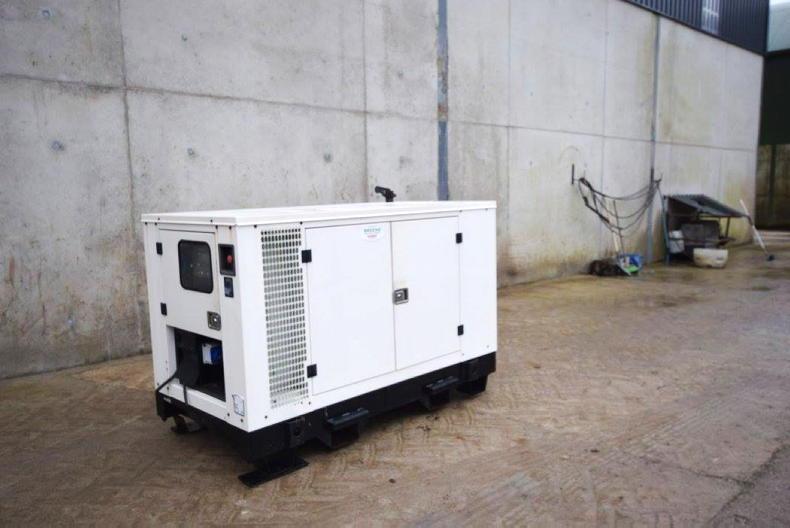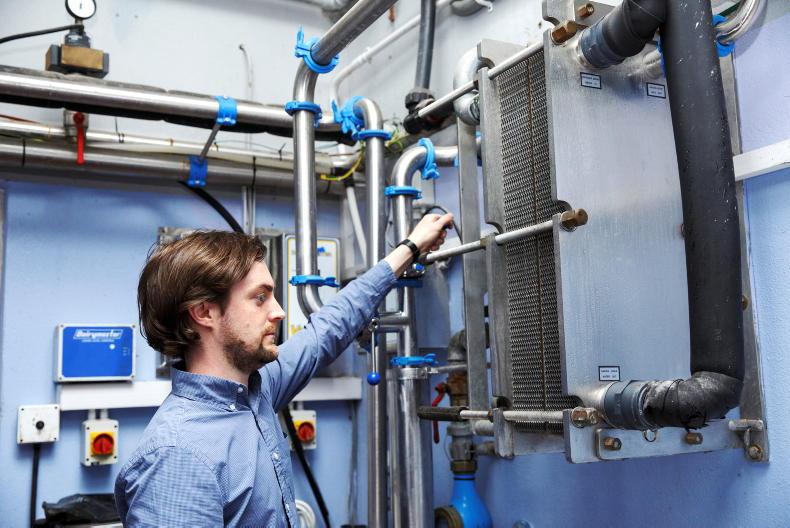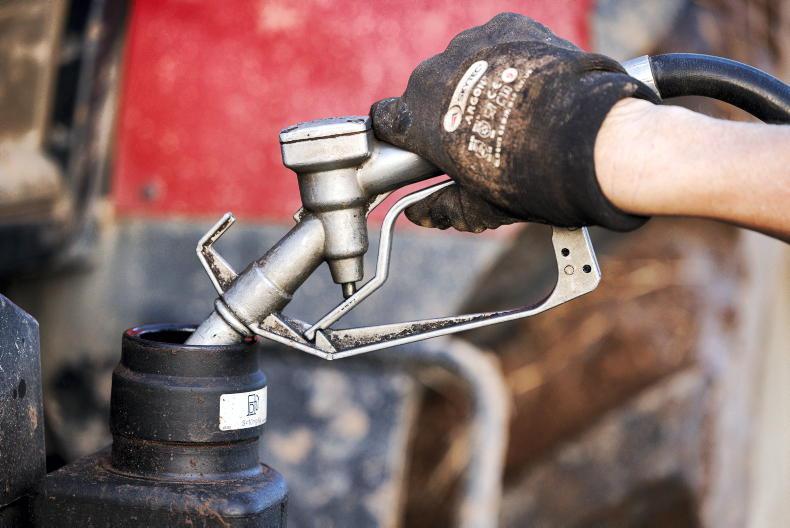With the electricity network set to come under more pressure this winter and in the years ahead, there’s more and more interest in generators on farms.
Up to now, backup generators were the domain of dairy, pig and poultry farms that need electricity for milking and feeding of stock and animal welfare. However, with an increased likelihood of blackouts, if not this winter then future winters, more and more farmers and even homeowners are considering buying backup generators.
The usual reason for a blackout in Ireland is due to an adverse weather event and we saw lots of examples of these in recent years where electricity was lost and took days for it to be recovered. However, there is now an increased risk of blackouts due to the electricity grid being overloaded and unable to cope with demand.
A generator is a prudent investment for all farmers, especially for those mentioned who rely on electricity to farm. It’s less of a concern for drystock farmers but that could change if blackouts become more common.
Most farms are on the same connection as the house, so providing backup power to the farm will, in most cases at least, also provide electricity to the house – keeping everyone fed and warm and, as importantly, keeping the internet going.
PTO
There are two main types of generators used on Irish farms. The most common is a PTO-powered generator which is powered by a tractor. These can be connected to the power supply at the meter whenever the power goes down. Importantly, a changeover switch must be installed to shut-off the connection from the grid.
Generally, these PTO-powered generators are either fixed or mobile. The fixed generators are bolted down while the mobile generators can be moved on a three-point linkage which is useful if the generator is being shared by a few people.
For those not registered for VAT, the VAT can be reclaimed for fixed generators but not mobile generators. There is a range of different sized generators available and what size you buy should be determined by the load the generator will be asked to run.
For medium-sized dairy farms, a 33kVA generator is usually sufficient to comfortably power the milking parlour, bulk tank and scrapers, etc. In terms of power requirement, a bulk tank is one of the most power-hungry applications on the farm when it gets turned on first.
Smaller generators are available and are cheaper to buy but they might come under pressure if say a larger bulk tank is purchased in the future or if the bulk tank, scraper and a shower in the house kick in at the same time.
Obviously, farmers with a three-phase supply will need to purchase a three-phase generator and these are usually rated for much higher power than single-phase generators.
Standby
Standby generators are the most common type of generators used in industry and on commercial buildings. These are diesel or gas-powered generators with their own engines and so don’t require a tractor to power them.
In most cases, these generators are wired to automatically kick in, in the event that the power goes down. That is why if you’re ever in a big building and power is lost, there is often a few seconds’ delay for the power to come back on.
These standby generators have usually been used on larger pig and poultry units so power can be maintained at any time, day or night. In recent years, more and more larger dairy farms have also been installing these type of generators as they do away with the requirement for employees to set up PTO-powered generators.
They also have a role to play where a tractor may not be readily available or where staff don’t have tractor-driving training.
The downside of these generators is that they are more expensive to install and a direct feed fuel supply is needed for them to work. These generators should be tested a few times a month when not in use. Most modern standby generators can be programmed to turn on and run for an hour or so at regular intervals.
Safety
A generator should never be connected on a temporary basis to the electrical circuits in your premises or to your metering point. To do so could endanger you, your neighbours and ESB Networks’ staff.
Cost
Bradley PTO Generators is one of the main manufacturers of PTO-powered generators in Ireland and offers a range of different-sized options for different farms. A standard single phase 33kVA mobile generator will cost €4,500, excluding VAT, but including electrical sockets. Matty Walsh runs MW Hire which sells and hires out diesel powered standby generators. He says that amps are as important as kVA when determining what size generator is needed. An entry-level diesel generator with single- or three-phase capability for a standard dairy farm will cost approximately €7,500 plus VAT and an automatic transfer switch, which will kick in as soon as power goes, will cost over €1,000.
In brief
With an increased likelihood of blackouts due to pressure on the grid, more farmers are considering buying generators. The generator should be a size appropriate to the power needs of the farm. If using a PTO-powered generator make sure it is set up correctly.If a standby generator is installed, make sure it is tested and serviced regularly, even if not in use.
With the electricity network set to come under more pressure this winter and in the years ahead, there’s more and more interest in generators on farms.
Up to now, backup generators were the domain of dairy, pig and poultry farms that need electricity for milking and feeding of stock and animal welfare. However, with an increased likelihood of blackouts, if not this winter then future winters, more and more farmers and even homeowners are considering buying backup generators.
The usual reason for a blackout in Ireland is due to an adverse weather event and we saw lots of examples of these in recent years where electricity was lost and took days for it to be recovered. However, there is now an increased risk of blackouts due to the electricity grid being overloaded and unable to cope with demand.
A generator is a prudent investment for all farmers, especially for those mentioned who rely on electricity to farm. It’s less of a concern for drystock farmers but that could change if blackouts become more common.
Most farms are on the same connection as the house, so providing backup power to the farm will, in most cases at least, also provide electricity to the house – keeping everyone fed and warm and, as importantly, keeping the internet going.
PTO
There are two main types of generators used on Irish farms. The most common is a PTO-powered generator which is powered by a tractor. These can be connected to the power supply at the meter whenever the power goes down. Importantly, a changeover switch must be installed to shut-off the connection from the grid.
Generally, these PTO-powered generators are either fixed or mobile. The fixed generators are bolted down while the mobile generators can be moved on a three-point linkage which is useful if the generator is being shared by a few people.
For those not registered for VAT, the VAT can be reclaimed for fixed generators but not mobile generators. There is a range of different sized generators available and what size you buy should be determined by the load the generator will be asked to run.
For medium-sized dairy farms, a 33kVA generator is usually sufficient to comfortably power the milking parlour, bulk tank and scrapers, etc. In terms of power requirement, a bulk tank is one of the most power-hungry applications on the farm when it gets turned on first.
Smaller generators are available and are cheaper to buy but they might come under pressure if say a larger bulk tank is purchased in the future or if the bulk tank, scraper and a shower in the house kick in at the same time.
Obviously, farmers with a three-phase supply will need to purchase a three-phase generator and these are usually rated for much higher power than single-phase generators.
Standby
Standby generators are the most common type of generators used in industry and on commercial buildings. These are diesel or gas-powered generators with their own engines and so don’t require a tractor to power them.
In most cases, these generators are wired to automatically kick in, in the event that the power goes down. That is why if you’re ever in a big building and power is lost, there is often a few seconds’ delay for the power to come back on.
These standby generators have usually been used on larger pig and poultry units so power can be maintained at any time, day or night. In recent years, more and more larger dairy farms have also been installing these type of generators as they do away with the requirement for employees to set up PTO-powered generators.
They also have a role to play where a tractor may not be readily available or where staff don’t have tractor-driving training.
The downside of these generators is that they are more expensive to install and a direct feed fuel supply is needed for them to work. These generators should be tested a few times a month when not in use. Most modern standby generators can be programmed to turn on and run for an hour or so at regular intervals.
Safety
A generator should never be connected on a temporary basis to the electrical circuits in your premises or to your metering point. To do so could endanger you, your neighbours and ESB Networks’ staff.
Cost
Bradley PTO Generators is one of the main manufacturers of PTO-powered generators in Ireland and offers a range of different-sized options for different farms. A standard single phase 33kVA mobile generator will cost €4,500, excluding VAT, but including electrical sockets. Matty Walsh runs MW Hire which sells and hires out diesel powered standby generators. He says that amps are as important as kVA when determining what size generator is needed. An entry-level diesel generator with single- or three-phase capability for a standard dairy farm will cost approximately €7,500 plus VAT and an automatic transfer switch, which will kick in as soon as power goes, will cost over €1,000.
In brief
With an increased likelihood of blackouts due to pressure on the grid, more farmers are considering buying generators. The generator should be a size appropriate to the power needs of the farm. If using a PTO-powered generator make sure it is set up correctly.If a standby generator is installed, make sure it is tested and serviced regularly, even if not in use. 









SHARING OPTIONS